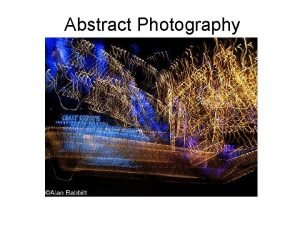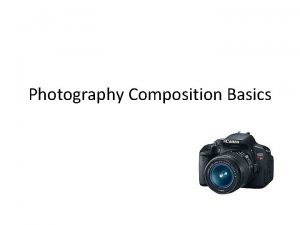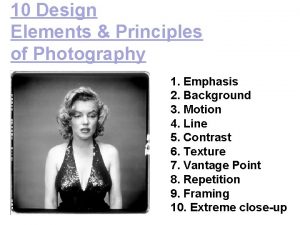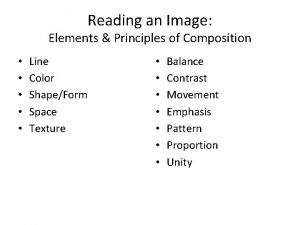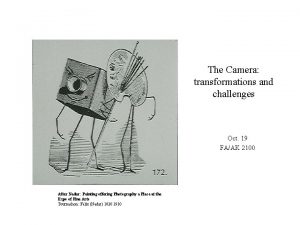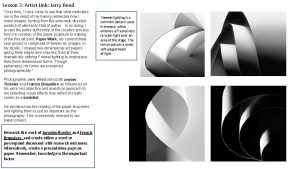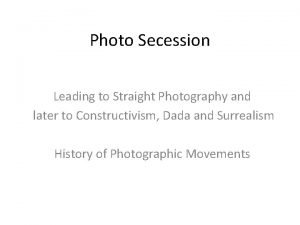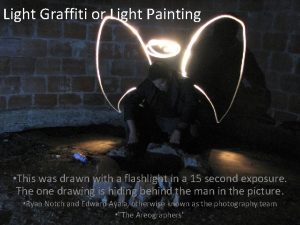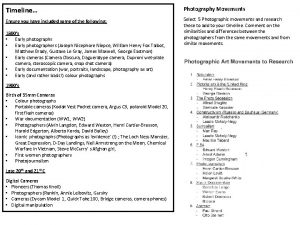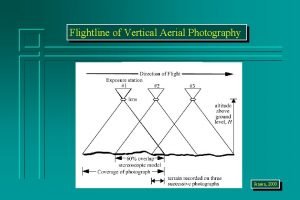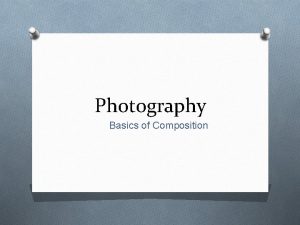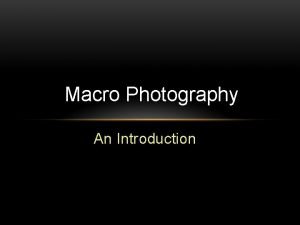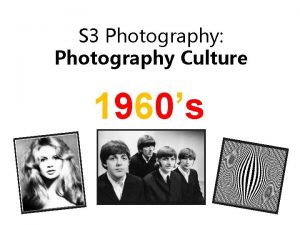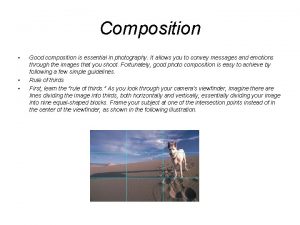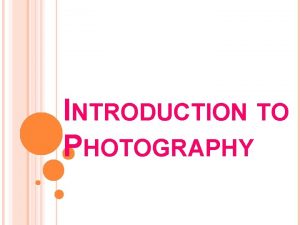Elements of Composition in Photography Elements of Composition

















































- Slides: 49

Elements of Composition in Photography

Elements of Composition l In general, good photographs result from careful attention to some basic elements of composition, together with appropriate lighting and an interesting subject. l There is, however, no “right way” to take a photograph. 3 photographers recording the same scene may create equally appealing photos with entirely different composition.

Guidelines – Not Rules l Even though the following principles have emerged for good composition-and they seem rather clear-they should always be considered guidelines, not rules. l Composition is an art, not a science

Fill the Frame l 1. Move up close to Fill the Frame – The biggest mistake that beginning photographers will make is not getting in close enough – Move yourself closer or use the Zoom

Fill the Frame This is my daughter, Alexis, at the age of 2. (She was excited to have her hair in pigtails. ) Notice that I didn’t include the whole chair or even her whole body. The focus is on her upper body and her pig-tails. That was the whole reason for the photo.

Fill the Frame This is Alexis, age 2, playing in the backyard. Notice how I filled the frame and focused in on just her with the water sprinkler. I didn’t show everything in my backyard.

Fill the Frame

Fill the Frame My Niece Abby

Center of Visual Interest l 2. Compose around a Center of Visual Interest – Compose your photo around your theme – Does the shot fit theme? – Stay away from multiple centers of interest! Look for a SINGLE Center of Visual Interest

Center of Visual Interest Where is the single center of interest? Some people say the road, and some people say the motorcycle. Too much stuff will make your photo look busy.

Center of Visual Interest Think of each shot as having a theme or a common idea throughout.

Center of Visual Interest l Simplicity Be sure that only the things you want the viewer to see appear in the picture. If there are numerous objects cluttering up the background, your message will be lost.

Center of Visual Interest What does your mind focus on here? Most people say the center of interest is the cookie/chocolate chips. The milk in the background is there to help add to theme of the cookie. But it does not over power the center of interest (cookie).

Center of Visual Interest Effective use? Your answer is hopefully: NO. The background is too cluttered for a single center of interest. To improve this photo, the photographer would have to zoom in more and focus on the upper bodies of the players and the ball. This would eliminate the crowd in the background plus help you see the players’ faces better.

Proper Subject Placement l 3. Observe Proper Subject Placement – Take the time to position your subjects. – Take the time to move the camera to position the objects within the frame Rule of thirds l Lead the subject l

Rule of Thirds • In Rule of Thirds the total image area is divided vertically and horizontally into three equal sections. • Although it is often best to place the center of interest somewhere along the two horizontal and two vertical lines, generally, composition is even stronger if the center of interest falls near one of the four cross-points.

Rule of Thirds Divide these photos vertically and horizontally into thirds and you will see that the center of interest is at a cross-point.

Rule of Thirds Sometimes you can get a neat effect by using objects/buildings to create “real” lines for Rule of Thirds as well.

Rule of Thirds In this photo, there actually 2 centers of interest (the horse’s head and the girl’s head). But this photo works well with the 2 areas because the photographer put them each in a cross-point.

Leading the Subject • Looking Space – give your subject room to look or move in your photograph • Generally, when a subject is moving in a particular direction, space is provided at the side of the frame for the subject(s) to "move into. " This is referred to as leading the subject.

Leading the Subject This is a picture of my daughter and I (taken a few years ago) playing along the Missouri River. You notice that we have room to look or move in the photo. This is another example of “Leading the Subject”.

Leading Lines direct the viewer’s attention to the center of visual interest. • In addition to moving our eyes around the frame, lines can suggest meaning in themselves. • Follow these curved lines up to the old farm house. Without these curved lines, the photo would be a boring photo of an old house. The lines add interest to your picture.

Using Lines l Horizontal lines=stability, openness l Vertical lines=power, height, restriction l Curved lines=grace, beauty l S-lines= gracefulness, leads eye to center

Horizontal Lines = Openness

Vertical Lines = Power, Height

Curved Lines = Grace, Beauty Below is a photo using a curved line to help follow your eye around the flower pot to the plant. The above photo was taken at a park on a play set. You can see how your eye follows the curve of the play set leads your eye down to the girl sitting on the ground.

S Lines = Gracefulness, Leads eye to center

Horizontal and Vertical Lines ? confusing? This photo looks way too busy and confusing. Don’t combine vertical, horizontal, or curved lines together into 1 photo. It is distracting and starts to hurt your eyes.

Framing l 5. Frame the central subject matter – Use objects in the foreground to frame your shot – Adds “depth” to the photograph – Framing a scene holds attention within the shot and keeps viewers' attention from wandering or being distracted from the center of interest.

Frame Central Subject Matter To show a common example, leaning tree branches at the top of a scenic shot breaks up a bright sky and acts as a visual barrier or “stop point” for the top of the frame. Note in the photo above how framing a shot with foreground objects adds depth and dimension.

Framing

Mikala - dpchallenge. com

Framing

Perspective l 6. Use visual perspective – Look for Creative Angles – Take an ordinary photo and make it unique through the camera’s perspective – Move yourself and your camera to a different position to look for a different perspective

Perspective

Visual Perspective

Visual Perspective

Visual Perspective

Visual Perspective

Repetition l 7. Repetition of shapes can draw a viewer into the photograph My nephews, Jacob and Isaac

Repetition can be found in colors, shapes, objects, etc.

Repetition

Repetition It can often be the break in repetition that makes an effective photograph Thelsel – dpchallenge. com

Other Things to Watch For l A. Avoid Mergers = adjust your shot! – Tonal mergers l Too much of same color – Dimensional mergers l Light post out of subjects head – Border mergers l Subject cut off by frame, l Car shot, but can’t see wheels

Tonal Mergers Tonal mergers result when important objects in a scene appear to blend together and lose their identity. This is because the objects are of similar tonal or color values, or because of lighting problems. Note in the above photo that the butterfly gets lost in the yellow flower.

Tonal Mergers A common example of dark hair blending into a dark background. Try to separate the child's hair from the background… Whenever separate elements in a scene merge together in this way you have a tonal merger.

Dimensional Mergers Dimensional mergers are when an important single center of interest runs together with an object in the background such as a tree, lighting fixtures, street signs, etc.

Border Mergers Border mergers occur when a subject matter is cut off by the edge of the frame — at an inappropriate point. A shot of an individual cropped at the calves looks awkward. Cropping off 1 foot or hand in a shot gives a similar result. A shot of a woman in a strapless dress cropped just above the top of the dress gives the illusion she is "topless. "

Time for you to COMPOSE some GREAT photographs! Attached to this lesson is a separate Word document that clearly outlines the lesson goals, and required photos for this assignment. It would be beneficial for you to print the Word document to bring with when you take pictures.
 Is abstract photography same as conceptual photography
Is abstract photography same as conceptual photography Photography elements and principles
Photography elements and principles Viewpoint composition photography
Viewpoint composition photography Asymmetrical balance in photography
Asymmetrical balance in photography Digital photography composition
Digital photography composition Photography exercises
Photography exercises Radial balance art
Radial balance art Viewpoint composition photography
Viewpoint composition photography Tone formal elements
Tone formal elements Photography elements and principles
Photography elements and principles Value element of art photography
Value element of art photography Photography elements and principles
Photography elements and principles Photos that show emphasis
Photos that show emphasis Elements of art photography
Elements of art photography Theatre technologies examples vce
Theatre technologies examples vce Elements and principles of composition
Elements and principles of composition Vladimir arkhipov photography
Vladimir arkhipov photography Image parallax in remote sensing
Image parallax in remote sensing Gabriel lippmann photography
Gabriel lippmann photography Photography
Photography It is a consistent orderly or pleasing arrangement of parts
It is a consistent orderly or pleasing arrangement of parts élevage de poussière
élevage de poussière Testicular feminization syndrome
Testicular feminization syndrome Drawing of crime
Drawing of crime Still life photography
Still life photography Conceptual photography definition
Conceptual photography definition What is darkroom photography
What is darkroom photography History of digital photography
History of digital photography Jerry reed paper photography
Jerry reed paper photography Straight modernist photography
Straight modernist photography Therapeutic photography exercises
Therapeutic photography exercises Light graffiti photography
Light graffiti photography Cetus en latin
Cetus en latin Photography movements timeline
Photography movements timeline Billy dinh photography
Billy dinh photography Beata hejmanowska
Beata hejmanowska Photography keywords gcse
Photography keywords gcse Photography quiz with answers
Photography quiz with answers Computational photography uiuc
Computational photography uiuc California modernist photography
California modernist photography Flight planner chris
Flight planner chris Codes and conventions photography
Codes and conventions photography Judging abstract photography
Judging abstract photography History of film photography
History of film photography Vertical aerial
Vertical aerial Shutter speed table
Shutter speed table The word “photography” literally means
The word “photography” literally means Fotografi berasal dari bahasa yunani graphein yang artinya
Fotografi berasal dari bahasa yunani graphein yang artinya Photography merit badge pamphlet
Photography merit badge pamphlet Fine art photography architecture
Fine art photography architecture
